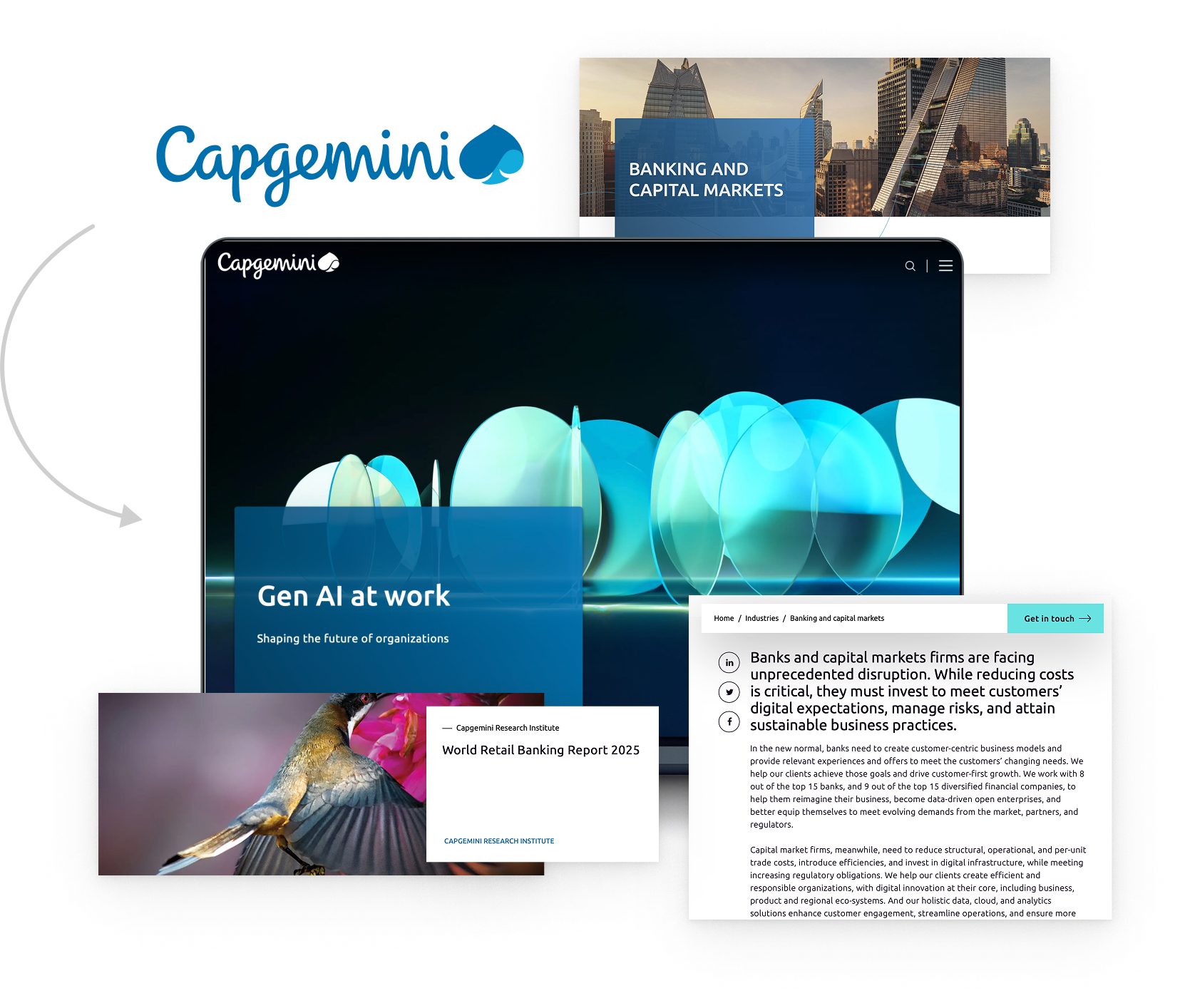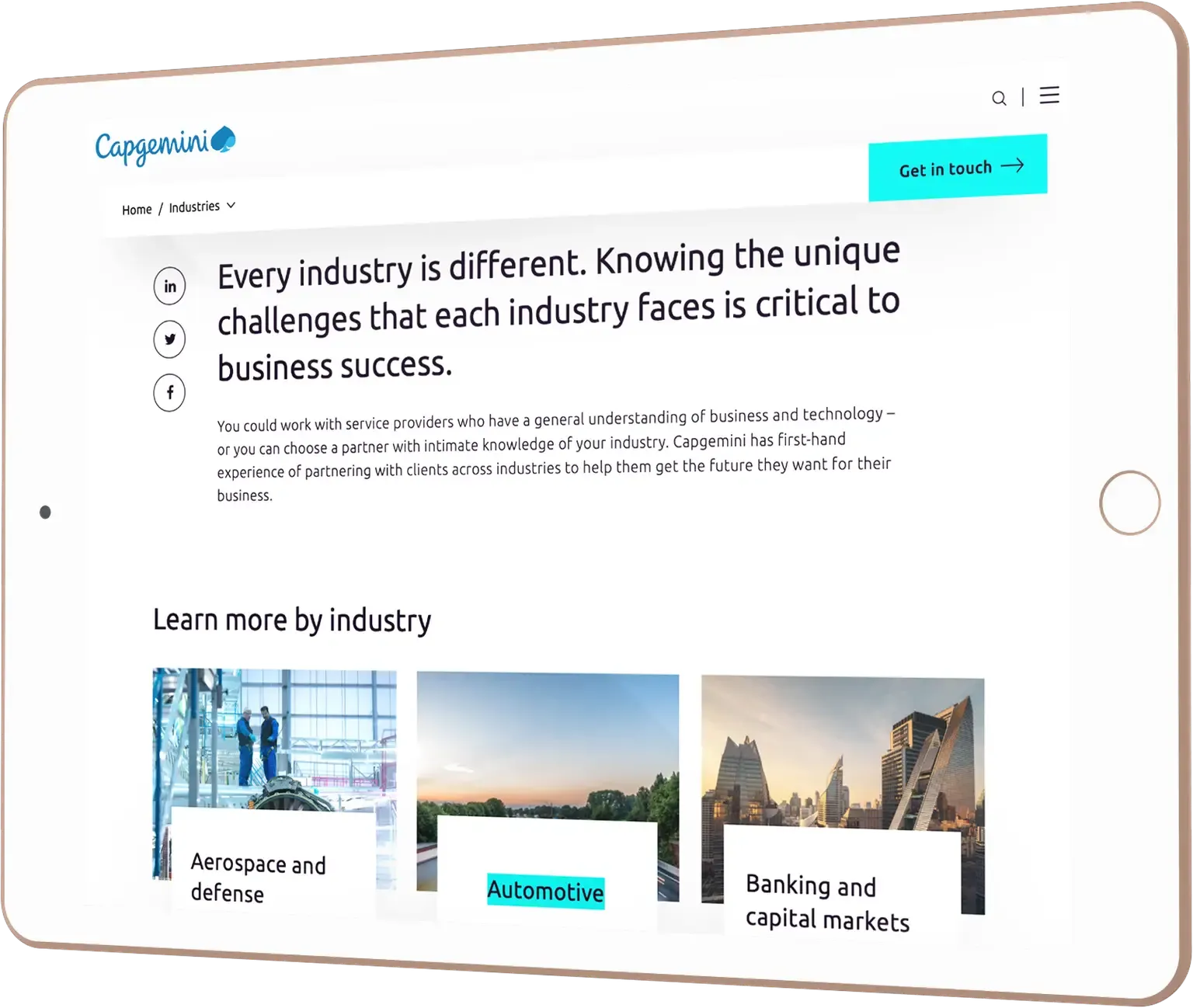Case study
A Drupal to WordPress migration for Capgemini
We migrated Capgemini from Drupal to WordPress, and helped embed a new culture of creation along the way.

Industry
Publishing, Technology
Services
Bespoke Development, Consultancy & Strategy
Humans

About Capgemini
Capgemini is a multi-billion-euro technology consultancy present in over 40 countries. They needed support in transitioning across to a new platform to help them develop new and more efficient workflows and processes to support their objectives.
They underwent a huge replatforming project, moving their network of 38 sites from their legacy Drupal CMS to WordPress. Drupal was no longer suitable for their editorial needs, and the lack of backwards compatibility with previous versions made the website increasingly unstable and difficult to use. Furthermore, the system no longer supported their digital roadmap, and teams across the organisation were becoming frustrated with the lack of usability and extensibility.
We were engaged to create a flexible and performant CMS tool on WordPress to support Capgemini’s various client and public facing web properties. This helped Capgemini leap into a new digital culture of creation with a robust, usable, and intuitive CMS which would help them deliver key business objectives as well as empower their global team network to be more effective.
A platform for business users
In 2012, Capgemini launched a series of websites using the Drupal 7 CMS platform. As the organisation evolved and demands on the platform increased, their Marketing & Communications team were experiencing blockers at almost every stage of the publishing process.
Capgemini realised that they had outgrown the platform: it became increasingly complex for the Web Operations (web opps) team to manage, and difficult for the Marketing & Communications team to use.
The recruitment team were also experiencing difficulties using the website to surface new job roles. At 200,000 people strong, Capgemini turnover tens of thousands of applicants a year, and keeping up with these demands requires a performant CMS. With fewer than five qualified Drupal webmasters in the organisation, the recruitment team were struggling to manage this.
“Digital became a choke point for us. The system we built wasn’t really working.”

Parker Ward, Director, Content Marketing and Communications, Capgemini

A culture of digital creation and syndication
Our first priority was to enable editorial teams to edit, modify, and update content on the website directly. WordPress’ inherent publishing capacity and baked-in capabilities for editorial workflows were instantly impactful, significantly improving the way in-house teams were working.
The Capgemini team wanted to invest in a CMS that could grow and evolve with the business through future transitions and periods of growth. The cost-effectiveness of migrating to WordPress was a bonus, and meant many of the publishing challenges Capgemini needed to alleviate were instantly improved without the need for a completely bespoke build.
A CMS with a low entry level would prevent a long and laborious onboarding period for publishers and their web opps team: with its native capacity to publish content in a simple, easy-to-use admin and user-friendly experience for new users, WordPress ticked all boxes.
One of the largest aspects of the Capgemini replatforming was content syndication, which involved a complex multisite, multilingual network, enabling localised and translated content to move across and between any of their 38 sites.
Capgemini’s desire to have different content structures across different sites, but retain the capacity to copy and translate content across from site to site, meant they needed a bespoke solution. We encapsulated both the translation and localisation required on the shared content, as well as enabling editorial flexibility so editors could make better use of the content they had available to them.
Currently, the content syndication is also being used for:
- sharing content between sites
- translations
- allowing editors reject or accept content from another site
- facilitating decision-making on content synchronisation or detachment from regional sites
- control over automatic updates to content

Platform architecture wins
The Capgemini replatforming project greatly decreased the technical skills required to work with their CMS, opening it up to more people in the organisation.
Our work supporting content experimentation enabled the MACS team to be responsive and reactive with campaigns, and we amplified this by creating a pre-built library of components for quick and easy usage.
“We needed to make the right technology choice for our business needs. We needed a CMS to empower local teams to be able to publish content, but stay within the corporate bounds of the Capgemini brand.”

Parker Ward, Director, Content Marketing and Communications
We reduced the cost and time required to bring new features to the platform through experimentation with content formats and web functionality to empower publishing teams. Richer content publishing was enabled by a custom templating system, facilitating consistent display and presentation of posts through the new CMS and new page templates.
The resulting platform was intuitive, flexible, and consistent, with a better and simpler UX and a dynamic interface enabling cross-population of content from different websites, sections, and domains. We delivered a CMS that liberated both the web opps and MACS teams, a straightforward blogging editor, and simplified workflows and processes.
Read the full Capgemini migration story
Go deeper into the details of our CMS migration for Capgemini scenes and see how we unlocked renewed editorial power for a multinational, multicultural brand.
This form may not be visible due to adblockers, or JavaScript not being enabled.
Latest and Greatest
See our work
Learn the latest and greatest in WordPress site building. We’re offering tutorials, tips and tricks, and video walkthroughs on our blog.
Tell us about your project 💭
Whether you’re looking for website development, digital consultancy, a WordPress audit, or something else, our global teams are here to provide expert support tailored to your business goals.
Share the details of your upcoming priorities and we’ll work with you to create the best solution.
This form may not be visible due to adblockers, or JavaScript not being enabled.


